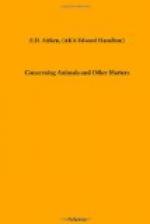When the axe is at last laid to the old coconut tree, a beam will fall to the earth sixty feet in length, hard as teak and already rounded and smoothed. True, you cannot saw it into planks, but no one will complain of that in a village which does not own a saw. It cleaves readily enough and straightly, forming long troughs most useful for leading water from the well to the plantation and for many other purposes. It can also be chopped into lengths suitable for the ridge poles of the hut, or for bridges to span the deep ditches which drain the rice fields or feed the salt pans. When out in quest of snipe I have sometimes had to choose between crossing by one of those bridges, innocent of even a handrail, and wading through the black slough of despond which it spanned. Choosing neither, I went home, but the “Kolee” and the “Agree” trip over them like birds, balancing household chattels on their steady heads.
We must not think, however, of the trunk as, at the best, anything more than a by-product of the coconut tree, whose head is more than its body. Even while it lives its head is shorn once a year, for, as fresh fronds push out and upward from the centre, those of the outer circle get old and must be cut away. And when one of those feathery, fern-like fronds, toying with the breeze, comes crashing to the ground, it is ten or twelve feet long, and consists of a great backbone, as thick at the base as a man’s leg, with a close-set row of swords on either side, about a yard in length. They are hard and tough, but supple yet and of a shiny green colour; but they will turn to brown as they wither.
Now observe that this gigantic, unmanageable-looking leaf, like everything else about the coconut tree, is almost a ready-made article, demanding no machinery to turn it to account, except the “koita” which hangs ever ready from the nude man’s girdle. With it he will cleave the backbone lengthwise, and then, taking each half separately, he will simply twist backwards every second sword and plait them all into a mat two feet wide, eight or ten feet long, and firmly bounded and held together on one side by the unbreakable backbone. This is a “jaolee,” lighter than slates, or tiles, and more handy than any form of thatch. You have just to arrange your “jaolees” neatly on your bamboo frame, each overlapping the one below it, then tie them securely in their places with coir rope and your roof is made for a year.
There is yet another benevolence of the coconut tree which I have left to the last, and the simple folk of whom I am trying to write with fellow feeling would certainly have named it first. I ought to refer to it as a curse: they, without qualm or question, call it a blessing. Let me try to describe it dispassionately. If you wander in any palm grove in Western India, looking upward, it will soon strike you that a large number of the trees do not seem to bear coconuts at all, but black earthen pots. If your visit should chance to be made early in the




